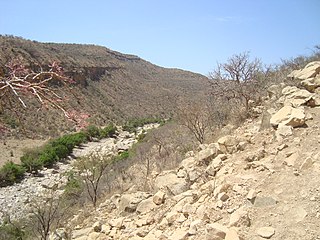
In polymer chemistry and materials science, a resin is a solid or highly viscous substance of plant or synthetic origin that is typically convertible into polymers. Resins are usually mixtures of organic compounds. This article focuses mainly on naturally occurring resins.

Myrrh is a gum-resin extracted from a number of small, thorny tree species of the genus Commiphora. Myrrh resin has been used throughout history as a perfume, incense and medicine. Myrrh mixed with posca or wine was widely used in many ancient cultures to produce pleasurable feelings and as an analgesic.

Incense is an aromatic biotic material that releases fragrant smoke when burnt. The term is used for either the material or the aroma. Incense is used for aesthetic reasons, religious worship, aromatherapy, meditation, and ceremony. It may also be used as a simple deodorant or insect repellent.

Frankincense is an aromatic resin used in incense and perfumes, obtained from trees of the genus Boswellia in the family Burseraceae. The word is from Old French franc encens. There are several species of Boswellia that produce true frankincense: Boswellia sacra, B. frereana, B. serrata, and B. papyrifera. Resin from each is available in various grades, which depends on the time of harvesting. The resin is hand-sorted for quality.

Boswellia is a genus of trees in the order Sapindales, known for its fragrant resin. The biblical incense frankincense is an extract from the resin of the tree Boswellia sacra, and is now produced also from B. frereana.

Styrax is a genus of about 130 species of large shrubs or small trees in the family Styracaceae, mostly native to warm temperate to tropical regions of the Northern Hemisphere, with the majority in eastern and southeastern Asia, but also crossing the equator in South America. The resin obtained from the tree is called benzoin or storax.

The Burseraceae are a moderate-sized family of 17-19 genera and about 540 species of woody flowering plants. The actual numbers given in taxonomic sources differ according to taxonomic revision at the time of writing. The Burseraceae are also known as the torchwood family, the frankincense and myrrh family, or simply the incense tree family. The family includes both trees and shrubs; its species are native to tropical regions of Africa, Asia, Australasia, and the Americas.

Iproniazid is a non-selective, irreversible monoamine oxidase inhibitor (MAOI) of the hydrazine class. It is a xenobiotic that was originally designed to treat tuberculosis, but was later most prominently used as an antidepressant drug. However, it was withdrawn from the market because of its hepatotoxicity. The medical use of iproniazid was discontinued in most of the world in the 1960s, but remained in use in France until its discontinuation in 2015.

Caryophyllene, more formally (−)-β-caryophyllene,(BCP), is a natural bicyclic sesquiterpene that is a constituent of many essential oils, especially clove oil, the oil from the stems and flowers of Syzygium aromaticum (cloves), the essential oil of Cannabis sativa, rosemary, and hops. It is usually found as a mixture with isocaryophyllene (the cis double bond isomer) and α-humulene (obsolete name: α-caryophyllene), a ring-opened isomer. Caryophyllene is notable for having a cyclobutane ring, as well as a trans-double bond in a 9-membered ring, both rarities in nature.

Boswellic acids are a series of pentacyclic terpenoid molecules that are produced by plants in the genus Boswellia. Like many other terpenes, boswellic acids appear in the resin of the plant that exudes them; it is estimated that they make up 30% of the resin of Boswellia serrata. While boswellic acids are a major component of the resin, the steam or hydro distilled frankincense essential oil does not contain any boswellic acid as these components are non-volatile and too large to come over in the steam distillation process.

Commiphora myrrha, called myrrh, African myrrh, herabol myrrh, Somali myrrhor, common myrrh, is a tree in the Burseraceae family. It is one of the primary trees used in the production of myrrh, a resin made from dried tree sap. The tree is native to the Arabian peninsula and to Africa. It is called 'mur' (المر) in Arabic, meaning bitter. It famously comes from Mecca, so it is called 'Mur Makki'.

Ferruginol is a natural phenol with a terpenoid substructure. Specifically, it is a diterpene of the abietane chemical class, meaning it is characterized by three fused six-membered rings and alkyl functional groups. Ferruginol was first identified in 1939 by Brandt and Neubauer as the main component in the resin of the Miro tree and has since been isolated from other conifer species in the families Cupressaceae and Podocarpaceae. As a biomarker, the presence of ferruginol in fossils, mainly resin, is used to describe the density of these conifers in that particular biosphere throughout time.

Boswellia sacra is a tree in the Burseraceae family, which is the primary tree in the genus Boswellia from which is frankincense is harvested. The olibanum tree is plant native to the Arabian Peninsula, specifically to the countries of Oman and Yemen, and to the Horn of Africa, specifically Somalia).

Boswellia papyrifera, also known as the Sudanese frankincense, is a species of flowering plant and frankincense that is native to Ethiopia, Eritrea and Sudan. The tree is cultivated in Ethiopia because of its valuable resin. The incense is characterized by a fresh lemon-pine scent and is therefore highly esteemed. In Ethiopia where it is called itan zaf, it comes in semi-translucent yellow tears. The gum resin of Boswellia papyrifera coming from Ethiopia, Sudan and eastern Africa is believed to be the main source of frankincense of antiquity.

Aquilaria sinensis is a species of plant in the family Thymelaeaceae. It is It is threatened by habitat loss. This medicinal plant is a source of fragrant wood, formed under a pathological condition, called Chen Xiang in Standard Mandarin, or chàhm hēung in Cantonese, or agarwood.
Arachidonate 5-lipoxygenase inhibitors are compounds that slow or stop the action of the arachidonate 5-lipoxygenase enzyme, which is responsible for the production of inflammatory leukotrienes. The overproduction of leukotrienes is a major cause of inflammation in asthma, allergic rhinitis, and osteoarthritis.

Lupeol is a pharmacologically active pentacyclic triterpenoid. It has several potential medicinal properties, like anticancer and anti-inflammatory activity.

Curzerene is a volatile, aromatic terpenoid found in many herbs and spices, such as Curcuma zeodaria. It is bioactive isolate of Caribbean corals and is also found in myrrh. More specifically it has been found to make up a significant portion - 12.97% - of the smoke produced from burning Commiphora myrrha oleo gum resin. It is also a major component of myrrh oil, which has been shown in vitro to possess anti-inflammatory properties at sub-toxic by inhibiting the production of the inflammatory cytokine IL-6 by human gingival fibroblasts. Anecdotal evidence exists to support the anti-inflammatory effect of myrrh oil.
Kindeya Gebrehiwot is an Ethiopian academic who is currently Professor of Forestry at Mekelle University (Ethiopia), undertaking research on forest regeneration, particularly frankincense trees. He studies the threats to this flagship species, particularly in relation to regrowth and tapping. He was also President of Mekelle University.
Ahmed Sulaiman Al-Harrasi is an Omani scientist and a professor of organic chemistry at the University of Nizwa, Nizwa, Sultanate of Oman.




















